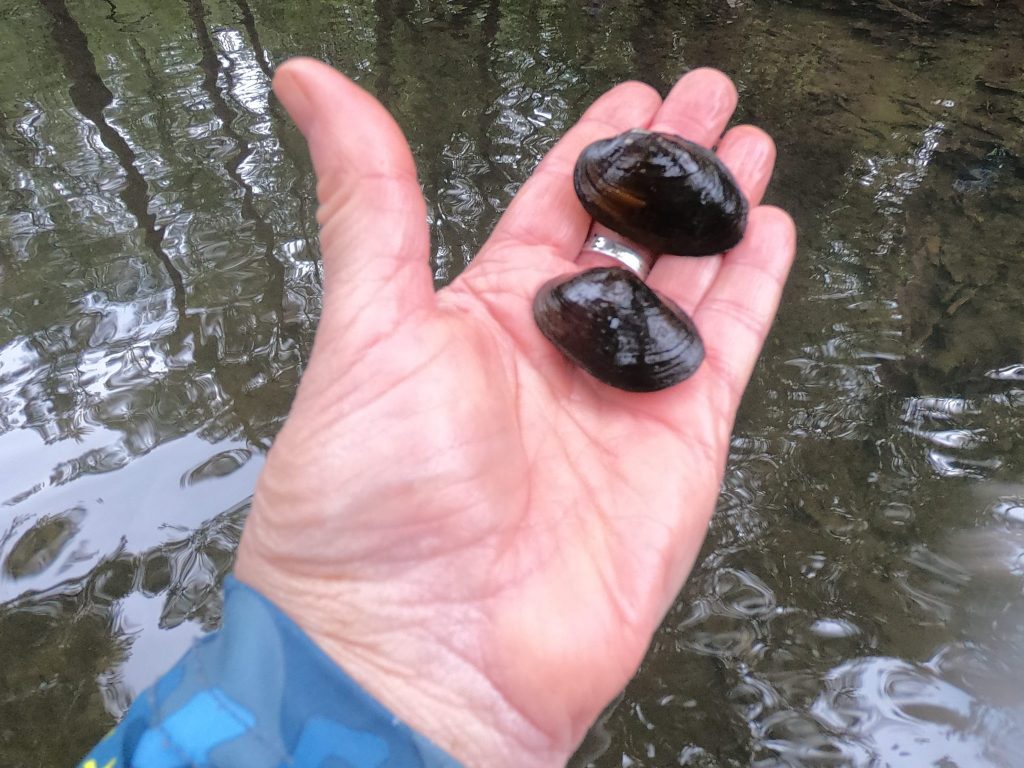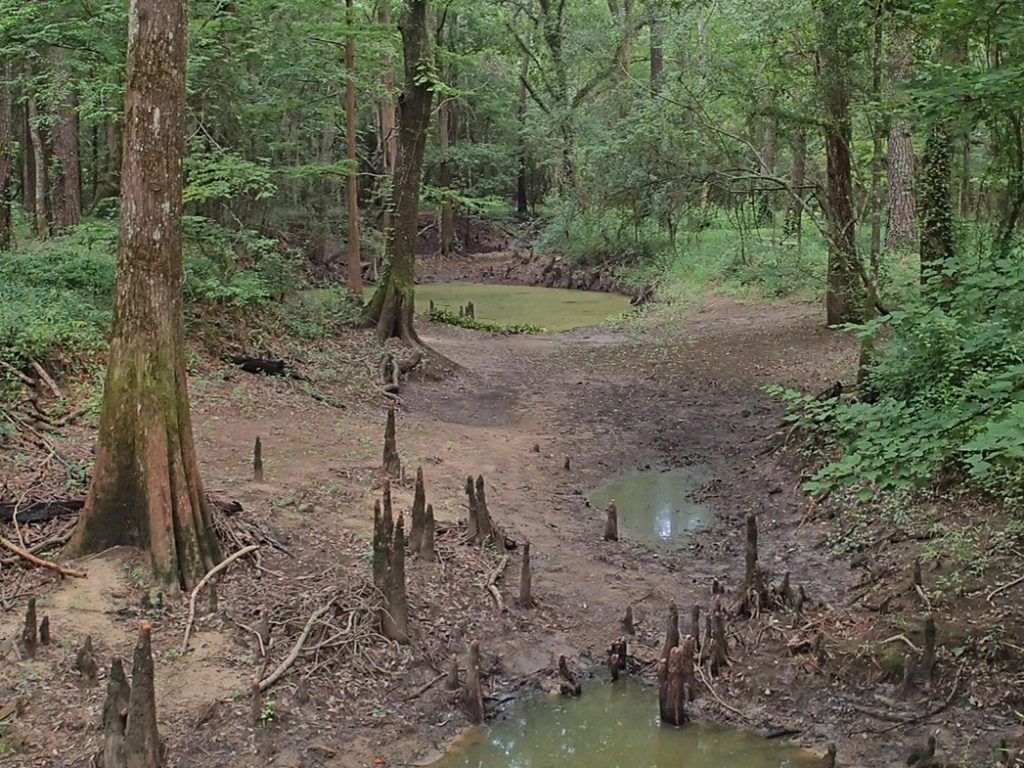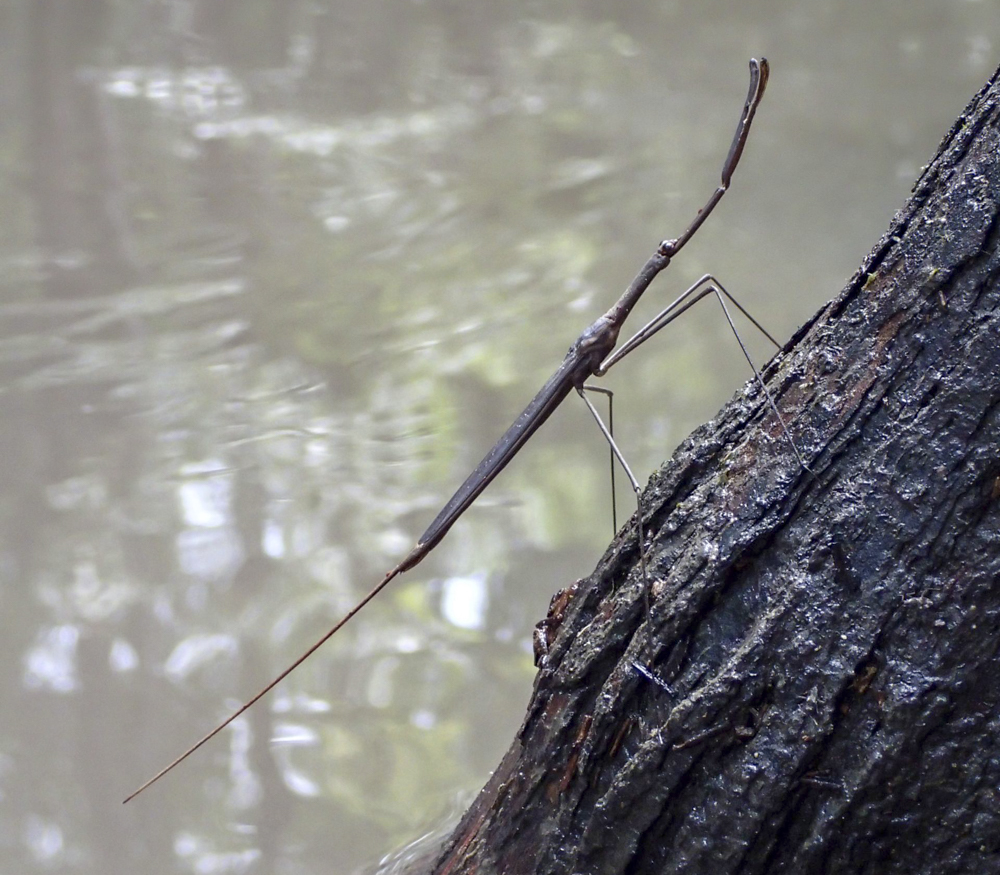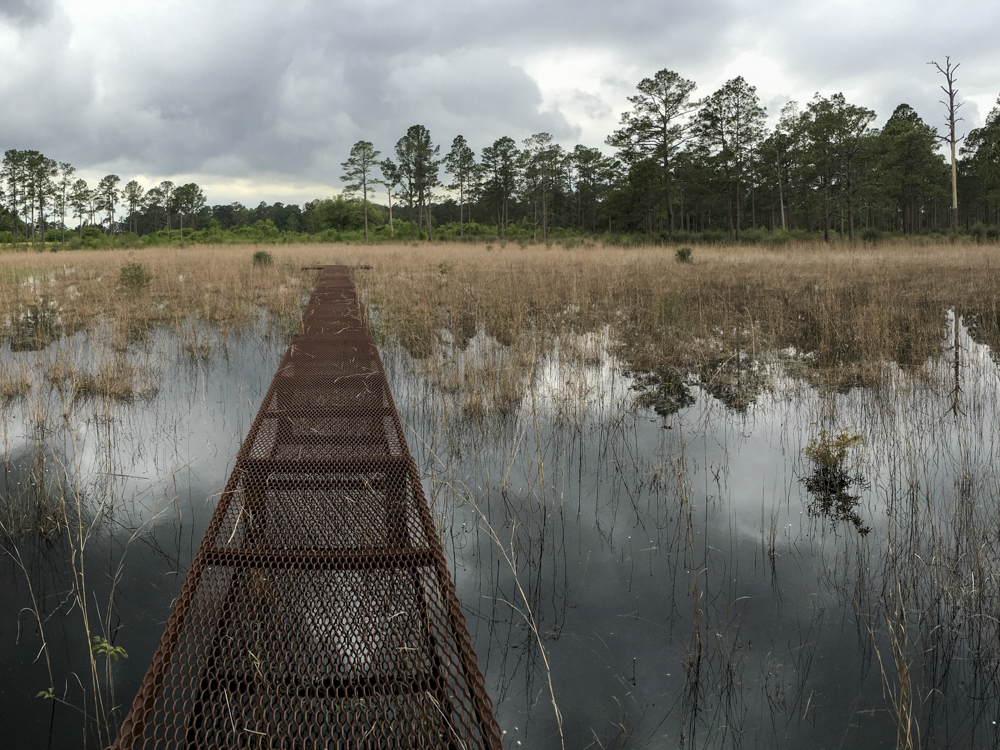Freshwater Mussels
Freshwater mussels are key inhabitants of many streams and rivers. They live in and on the sediment where they spend their lives filtering water to obtain nutrition. Because of this filtration, mussels provide many services to the ecosystem. Filtering purifies the water and mussel beds provide a nutrient rich habitat for other aquatic life.
Mussel communities of the lower Flint River Basin (LFRB) in southwestern Georgia are among the richest in the southeastern United States. Historically, 29 species of mussels, seven which were endemic, existed in our basin. We currently have five federally listed mussel species. The Fat Threeridge (Amblema neislerii), the Gulf Moccasinshell (Medionidus penicillatus), the Shinyrayed Pocketbook (Hamiota subangulata), and the Oval Pigtoe (Pleurobema pyriforme) are federally endangered. The Purple Bankclimber (Elliptoideus sloatianus) is federally threatened.
Developing a Habitat Conservation Plan
In southwestern Georgia, periodic droughts combined with warming temperatures and increasing water withdrawals have resulted in extremely low flows in the lower Flint River and its tributaries. Previously, we have documented declines in mussel abundance in streams subject to record low flow conditions. Once mussel populations are lost over large areas, remaining isolated populations may have little chance of contributing to recovery through the larger basin. Surveys we performed in the past as well as new surveys will provide information on how mussel populations have changed over time and provide updated information on species distribution. We performed 62 surveys in 2023 and recorded over 7,000 mussels for our work on the Habitat Conservation Plan.

Aquatic Habitat & Function
Water scarcity is causing once perennial streams to cease flowing or dry completely for extended periods. For historically intermittent streams and wetlands, periods where water is present have shortened. In the context of management, water is generally thought of in terms of discharge or yield. While this is a useful expression of water volume, it does not consider available habitat or habitat quality. Water quality parameters such as temperature and dissolved oxygen vary significantly as water depth changes.
We aim to provide measures of habitat quality by looking at how the characteristics of inundated areas change with changing discharge. In partnership with the Landscape Ecology Lab at the Jones Center, we are creating bathymetric maps of stream reaches with various methods (Acoustic Doppler Current Profiler, LiDAR, and drone photogrammetry). Once these maps are created, we can model the water depth across the stream reach at various discharge rates. As part of the Habitat Conservation Plan, this project aims to build resilience in our basin’s water management.

For more information see:
DuBose T. P., C. L. Atkinson, C. C. Vaughn, S. W. Golladay. 2019. Drought-induced, punctuated loss of freshwater mussels alters ecosystem function across temporal scales. Frontiers in Ecology and Evolution 7:1-13 DOI: https://doi.org/10.3389/fevo.2019.00274
Gagnon, P. M., S. W. Golladay, W. K. Michener, and M. C. Freeman. 2004. Drought responses of freshwater mussels (Unionidae) in coastal plain tributaries of the Flint River Basin, Georgia. Journal of Freshwater Ecology 19:667-679.
DOI: https://doi.org/10.1080/02705060.2004.9664749
Golladay, S. W., P. Gagnon, M. Kearns, J. M. Battle, and D. W. Hicks. 2004. Response of freshwater mussel assemblages (Bivalvia: Unionidae) to a record drought in the Gulf Coastal Plain of southwestern Georgia. Journal of the North American Benthological Society 23:494-506. DOI: https://doi.org/10.1899/0887-3593(2004)023<0494:ROFMAB>2.0.CO;2

Aquatic insects and crustaceans
Aquatic insects and crustaceans (like crayfish), spend most of their lives living in or on submerged surfaces in aquatic habitats. As consumers, their feeding promotes the recycling of plant and animal matter, and they serve as intermediate stages in aquatic food webs. Our ongoing research is examining how these aquatic organisms are responding to stream drying. Streams we have studied include perennial, near-perennial (ceased flowing but maintained a wetted channel during drought), intermittent-dry (seasonally dry), and intermittent-frequent (frequently dry). Distinct assemblages were documented across this gradient. Reaches that dried had a lower richness of aquatic insects, especially Ephemeroptera, Plecoptera, and Trichoptera taxa, partly due to inadequate time for life cycle completion and lack of adaptations to avoid drying. Intermittent reaches also included abundant and unique crustacean taxa such as Amphipoda and Isopoda. Projected trends towards increased temperature, water demand and drought occurrence in the region will shift communities towards drought-tolerant taxa as greater portions of stream networks become intermittent. The effect of these changes on aquatic food webs remains unknown.
For more information see:
Smith, C.R., P.V. McCormick, A.P. Covich, and S.W. Golladay. 2017. Comparison of macroinvertebrate assemblages across a gradient of flow permanence in an agricultural watershed. River Research and Applications 33: 1428-1438. DOI: https://doi.org/10.1002/rra.3211
Fishes
The southeastern US is noted for having the most diverse freshwater fish fauna in North America (662 species listed in river basins, Virginia to Texas). About 1/3 of these species are of conservation concern due to water extraction, pollution, habitat alteration, and introduction of invasive species. Much of the native diversity is non-game species, often little known or studied. In southwestern Georgia, increasing temperatures and water withdrawal are increasing the frequency and extent of stream drying.
Our study of fishes indicated that only a subset of species could tolerate stream drying. Thus, as stream intermittency becomes more extensive in extent and frequency, extirpation of species may occur. Fish species most tolerant of drying has specific life-history traits, often involved with reproductive and development timing that allowed survival. Our ongoing work is examining how fish food webs are responding to water scarcity and stream drying.

For more information see:
Fallon, C.E., K.C. Kapps, M.C. Freeman, C.R. Smith, S.W. Golladay. 2022. Effects of stream intermittency on minnow (Leucisidae) and darter (Percidae) trophic dynamics in an agricultural watershed. Ecology of Freshwater Fish. DOI:http://doi.org/10.1111/eff.12649
Davis, J.L. 2017. Stream fish response to intermittency and drying in the Ichawaynochaway Creek Basin. Odum School of Ecology, University of Georgia, Athens, GA. https://www.libs.uga.edu/etd
Davis J.L., M.C. Freeman, and S.W. Golladay. 2019. Identifying life-history traits that promote occurrence for four minnows (Leuscicidae) species in intermittent Gulf Coastal Plain streams. Southeastern Naturalist 19: 103-127.
Geographically Isolated Wetlands

Geographically isolated wetlands (GIWs) are called ‘isolated’ because they do not have visible surface channels to streams, rivers, or lakes. Lack of connection has caused them to be overlooked in considerations of water management and environmental health. They are an important part of the longleaf pine landscape. Relatively small in area compared to the surrounding woodland, their value is relatively much greater than the area they occupy.
Wetlands are known for extremely high biodiversity, high rates of carbon intake and storage, and can help improve water quality. However, many wetlands are degraded due to lack of water during drought and increased water demand from climate change. Land management can also have a major impact on how wetlands work.
We use isolated wetlands at Ichauway as reference sites to understand basic ecological processes. We also study how forest and agricultural land management affects GIWs regionally.
GIWs and Forest Restoration
A common restoration practice in longleaf pine landscapes is the removal of hardwoods like water oak. Just such a treatment was done a decade ago around a wetland on Ichauway, where about a third of all the trees were removed in a wetland catchment (the area of land that contributes water to the wetland).
Using water table data from years before and after this hardwood removal, we found this land management strategy greatly extended the period of standing water in the wetland. This effect was greatest during drought years. This study shows that managing the surrounding forest can help conserving wetland biota that depends upon long wet periods to reproduce and grow.
For more information see:
Golladay, S.W., B.A. Clayton, S.T. Brantley, C.R. Smith, J. Qi, D.W. Hicks. 2021. Forest restoration increases isolated wetland hydrology: a long term case study. Ecosphere. DOI:http://doi.org/10.1002/ecs2.3495
GIWs and Agricultural Runoff
Recent scientific evidence suggests that GIWs are important sources of water storage and can protect water quality at regional scales. Understanding and demonstrating the contributions of isolated wetlands is critically important because they are a source of regulatory uncertainty. We have assembled a team that is uniquely qualified to understand the contribution of isolated wetlands in a working agricultural area.
Our studies are designed to describe and measure fundamental wetland processes leading to water storage, improved water quality, and lead to management practices improving environmental health. Our project is also unique in that we intend to partner with agricultural producers at all stages of this work. We will document this engagement process through the development of educational materials that describe the process of discovery as the research team and landowners learn about isolated wetlands. We hope this material will serve as a roadmap for other research teams and landowners working to better manage land and water. This project is in cooperation with Auburn University and funded through the USDA.
